Network Layer: Internet Control Message Protocol (ICMP)
IP provides unreliable and connectionless datagram delivery. It was designed this way to make efficient use of network resources. The IP protocol is a best-effort delivery service that delivers a datagram from its original source to its final destination. However, it has two deficiencies: lack of error control and lack of assistance mechanisms.
The IP protocol has no error-reporting or error-correcting mechanism. What happens if something goes wrong? What happens if a router must discard a datagram because it cannot find a router to the final destination, or because the time-to-live field has a zero value? What happens if the final destination host must discard all fragments of a datagram because it has not received all fragments within a predetermined time limit? These are examples of situations where an error has occurred and the IP protocol has no built-in mechanism to notify the original host.
The IP protocol also lacks a mechanism for host and management queries. A host sometimes needs to determine if a router or another host is alive. And sometimes a network administrator needs information from another host or router. The Internet Control Message Protocol (ICMP) has been designed to compensate for the above two deficiencies. It is a companion to the IP protocol.
ICMP messages : error-reporting messages and query messages.
The error-reporting messages report problems that a router or a host (destination) may encounter when it processes an IP packet.
The query messages, which occur in pairs, help a host or a network manager get specific information from a router or another host. For example, nodes can discover their neighbors. Also, hosts can discover and learn about routers on their network, and routers can help a node redirect its messages.
ICMP Message Format
An ICMP message has an 8-byte header and a variable-size data section. Although the general format of the header is different for each message type, the first 4 bytes are common to all.
The first field, ICMP type, defines the type of the message.
The code field specifies the reason for the particular message type. The last common field is the checksum field.
The rest of the header is specific for each message type. The data section in error messages carries information for finding the original packet that had the error. In query messages, the data section carries extra information based on the type of the query.
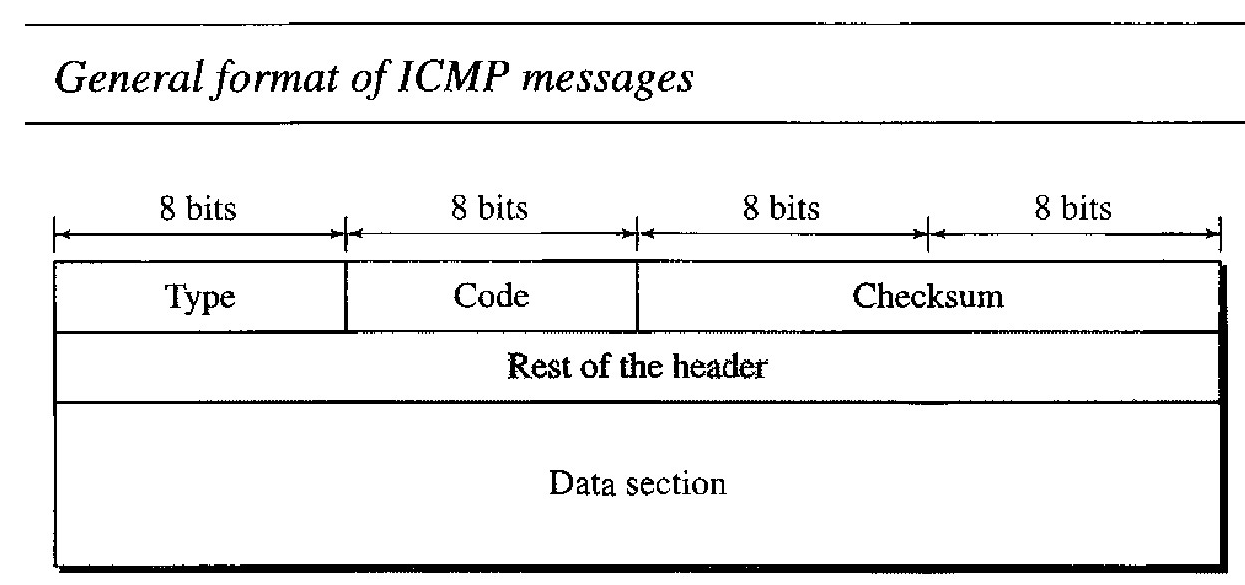
Error Reporting
One of the main responsibilities of ICMP is to report errors. Although technology has produced increasingly reliable transmission media, errors still exist and must be handled.
ICMP does not correct errors - it simply reports them. Error correction is left to the higher-level protocols. Error messages are always sent to the original source because the only information available in the datagram about the route is the source and destination IP addresses.
ICMP uses the source IP address to send the error message to the source (originator) of the datagram.
Five types of errors are handled: destination unreachable, source quench, time exceeded, parameter problems, and redirection.
Note that all error messages contain a data section that includes the IP header of the original datagram plus the first 8 bytes of data in that datagram. The original datagram header is added to give the original source, which receives the error message, information about the datagram itself.
The 8 bytes of data are included because the first 8 bytes provide information about the port numbers (UDP and TCP) and sequence number (TCP). This information is needed so the source can inform the protocols (TCP or UDP) about the error. ICMP forms an error packet, which is then encapsulated in an IP datagram .
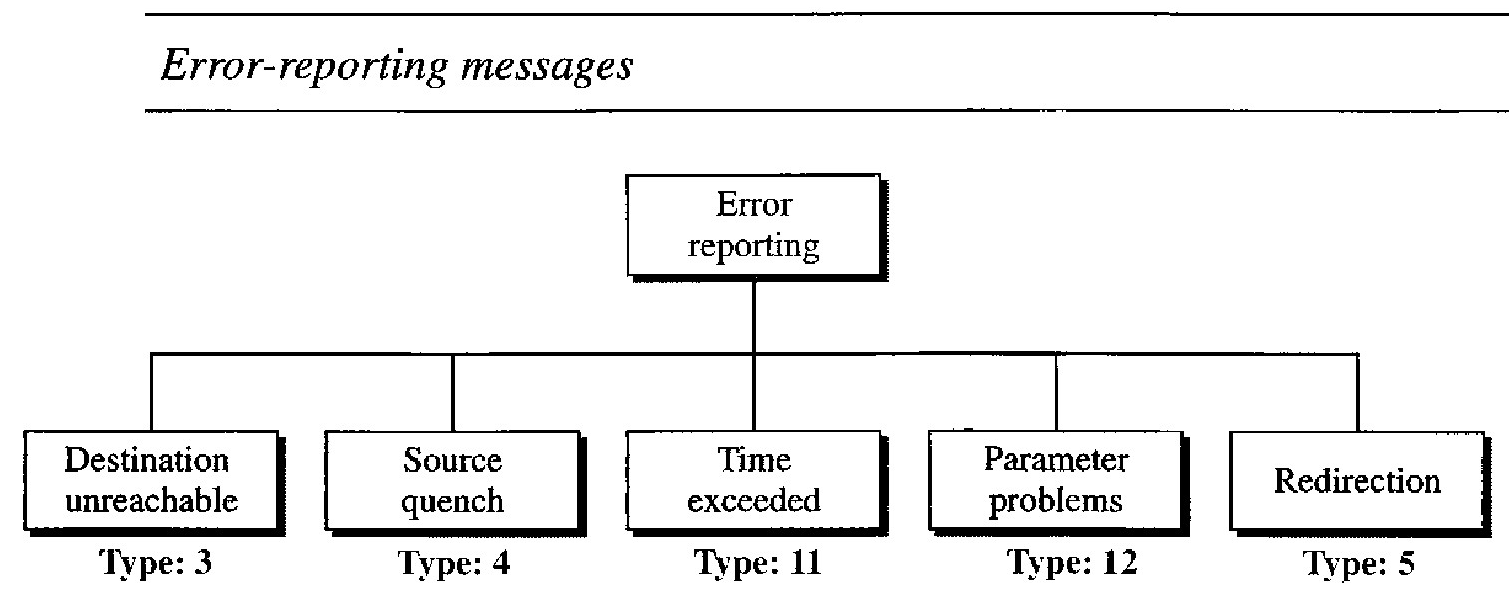
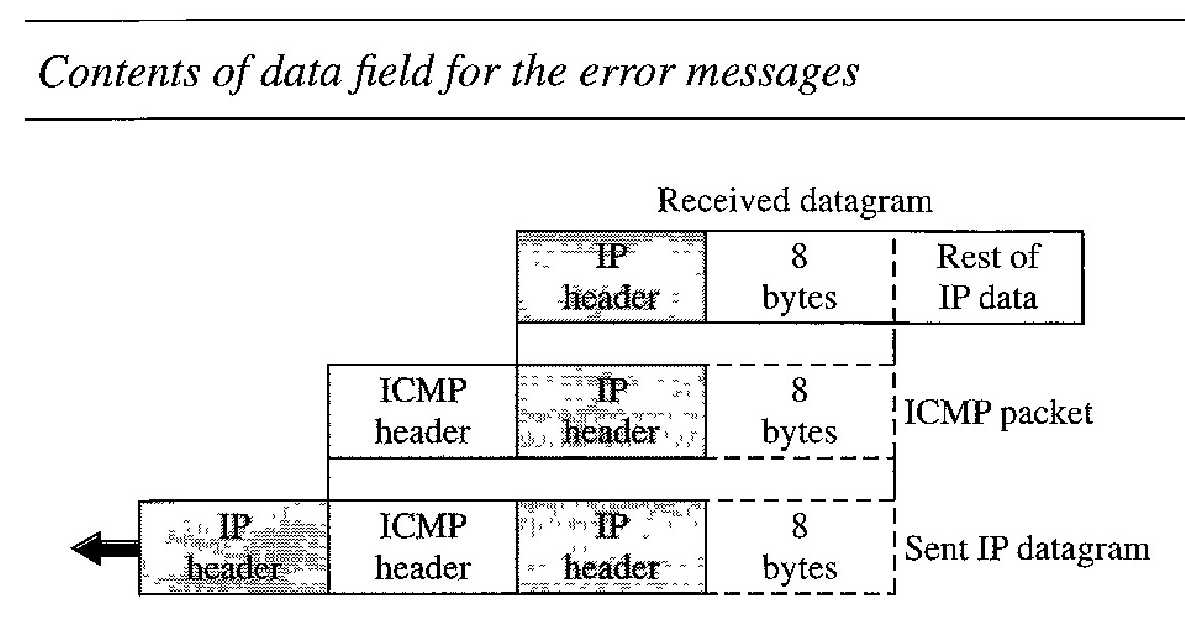
The following are important points about ICMP error messages:
No ICMP error message will be generated in response to a datagram carrying an IeMP error message.
No ICMP error message will be generated for a fragmented datagram that is not the first fragment.
No ICMP error message will be generated for a datagram having a multicast address.
No ICMP error message will be generated for a datagram having a special address such as 127.0.0.0 or 0.0.0.0.
ICMP Error-reporting messages
Destination Unreachable : When a router cannot route a datagram or a host cannot deliver a datagram, the datagram is discarded and the router or the host sends a destination-unreachable message back to the source host that initiated the datagram. Note that destination-unreachable messages can be created by either a router or the destination host.
Source Quench : The IP protocol is a connectionless protocoL There is no communication between the source host, which produces the datagram, the routers, which forward it, and the destina- tion host, which processes it. IP does not have a flow control mechanism embedded in the protocol. The lack of flow control can create a major problem in the operation of IP: congestion. The lack of flow control can create congestion in routers or the destination host. A router or a host has a limited-size queue (buffer) for incoming datagrams waiting to be forwarded (in the case of a router) or to be processed (in the case of a host). If the datagrams are received much faster than they can be forwarded or processed, the queue may overflow. When a router or host discards a datagram due to congestion, it sends a source-quench message to the sender of the datagram. This message informs the source that the datagram has been discarded. Second, it warns the source that there is congestion somewhere in the path and that the source should slow down (quench) the sending process.
Time Exceeded : Routers use routing tables to find the next hop (next router) that must receive the packet. If there are errors in one or more routing tables, a packet can travel in a loop or a cycle, going from one router to the next or visiting a series of routers endlessly. Each datagram contains a field called time to live that controls this situation. When a datagram visits a router, the value of this field is decremented by 1. When the time-to-live value reaches 0, after decrementing, the router discards the datagram. However, when the datagram is discarded, a time-exceeded message must be sent by the router to the original source. Second, a time-exceeded message is also generated when not all fragments that make up a message arrive at the destination host within a certain time limit.
Parameter Problem :Any ambiguity in the header part of a datagram can Create serious problems as the datagram travels through the Internet. If a router or the destination host discovers an ambiguous or missing value in any field of the datagram, it discards the datagram and sends a parameter-problem message back to the source.
Redirection :When a router or a host needs to send a packet destined for another network, it must know the IP address of the next appropriate router. Both routers and hosts, then, must have a routing table to find the address of the router or the next router. However, for efficiency, hosts do not take part in the routing update process because there are many more hosts in an internet than routers. Updating the routing tables of hosts dynamically produces unacceptable traffic. The hosts usually use static routing. When a host comes up, its routing table has a limited number of entries. It usually knows the IP address of only one router, the default router. For this reason, the host may send a datagram, which is destined for another network, to the wrong router. In this case, the router that receives the datagram will forward the datagram to the correct router. However, to update the routing table of the host, it sends a redirection message to the host.
Redirection concept in ICMP
Host A wants to send a datagram to host B
Router R2 is obviously the most efficient routing choice, but host A did not choose router R2.
The datagram goes to R1 instead. Router R1, after consulting its table, finds that the packet should have gone to R2. It sends the packet to R2 and, at the same time, sends a redirection message to host A. Host A's routing table can now be updated.
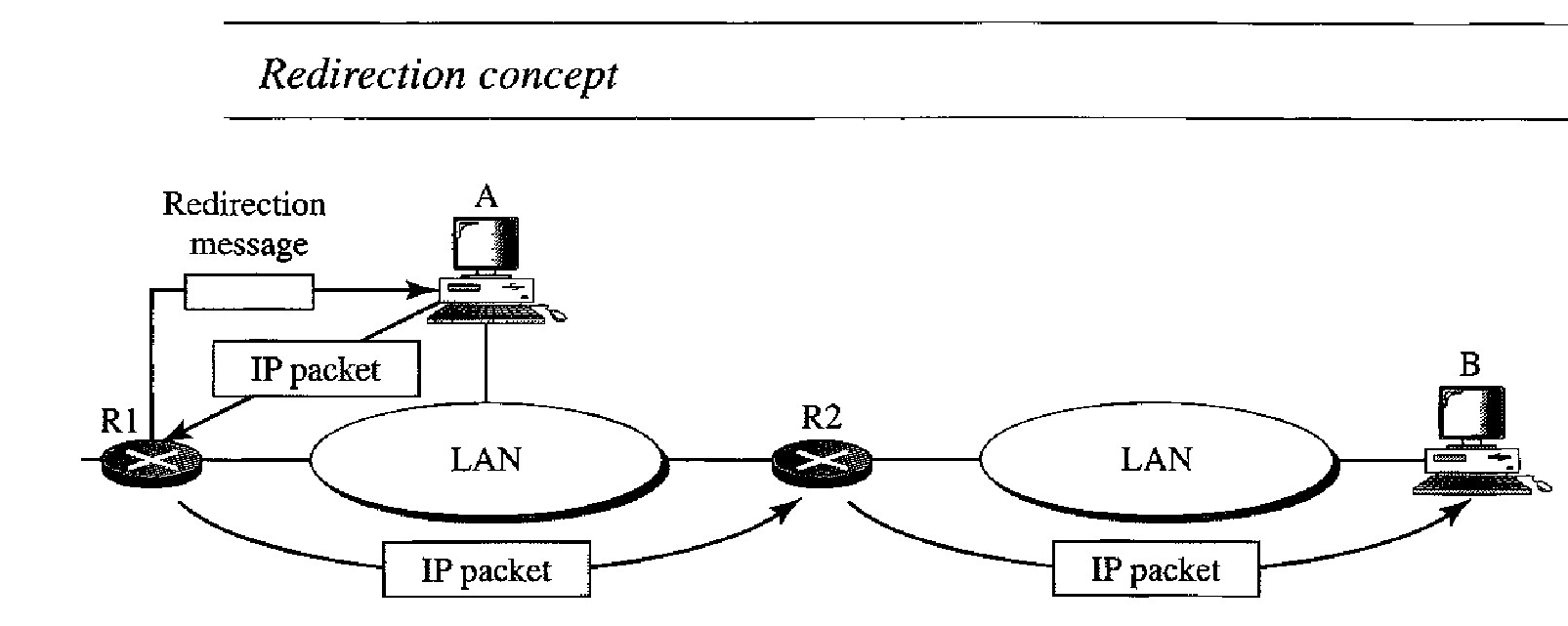
ICMP query messages
In this type of ICMP message, a node sends a message that is answered in a specific format by the destination node. A query message is encapsulated in an IP packet, which in tum is encapsulated in a data link layer frame. However, in this case, no bytes of the original IP are included in the message.
Echo Request and Reply :The combination of echo-request and echo-reply messages determines whether two systems (hosts or routers) can communicate with each other. The echo-request and echo-reply messages can be used to determine if there is communication at the IP level. Because ICMP messages are encapsulated in IP datagrams, the receipt of an echo-reply message by the machine that sent the echo request is proof that the IP protocols in the sender and receiver are communicating with each other using the IP datagram. Also, it is proof that the intermediate routers are receiving, processing, and forwarding IP datagrams.
Timestamp Request and Reply : Two machines (hosts or routers) can use the timestamp request and timestamp reply messages to determine the round-trip time needed for an IP datagram to travel between them. It can also be used to synchronize the clocks in two machines.
Address-Mask Request and Reply : A host may know its IP address, but it may not know the corresponding mask. To obtain its mask, a host sends an address-mask-request message to a router on the LAN. If the host knows the address of the router, it sends the request directly to the router. If it does not know, it broadcasts the message. The router receiving the address-mask-request message responds with an address-mask-reply message, providing the necessary mask for the host. This can be applied to its full IP address to get its sub net address.
Router Solicitation and Advertisement : A host that wants to send data to a host on another network needs to know the address of routers connected to its own network. Also, the host must know if the routers are alive and functioning. The router-solicitation and router-advertisement messages can help in this situation. A host can broadcast (or multicast) a router-solicitation message. The router or routers that receive the solicitation message broadcast their routing information using the router-advertisement message. A router can also periodically send router-advertisement messages even if no host has solicited. Note that when a router sends out an advertisement, it announces not only its own presence but also the presence of all routers on the network of which it is aware.
Checksum : In ICMP the checksum is calculated over the entire message (header and data).
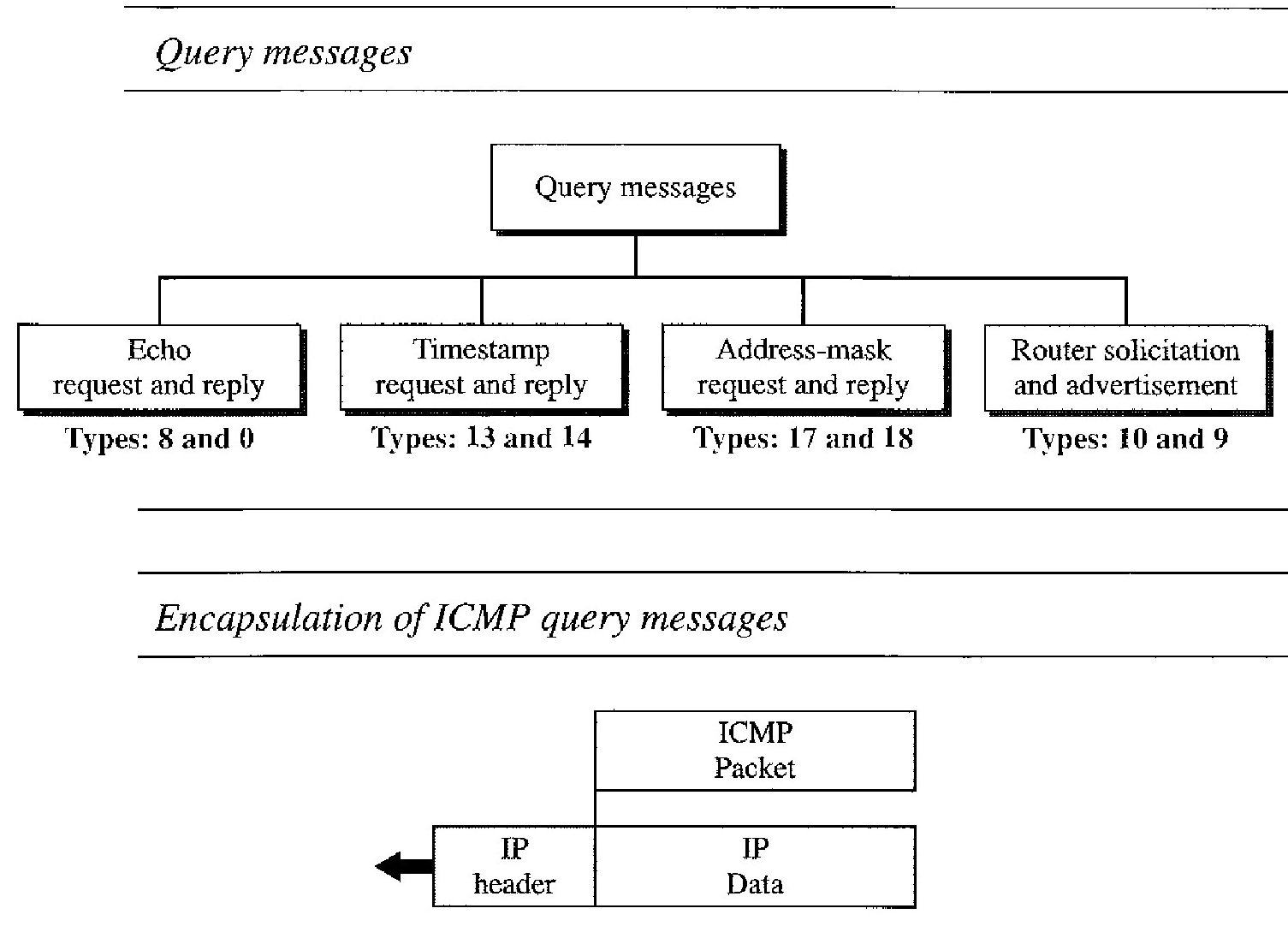
Q. Below figure shows an example of checksum calculation for a simple echo-request message. We randomly chose the identifier to be 1 and the sequence number to be 9.
The message is divided into 16-bit (2-byte) words.
The words are added and the sum is complemented. Now the sender can put this value in the checksum field.
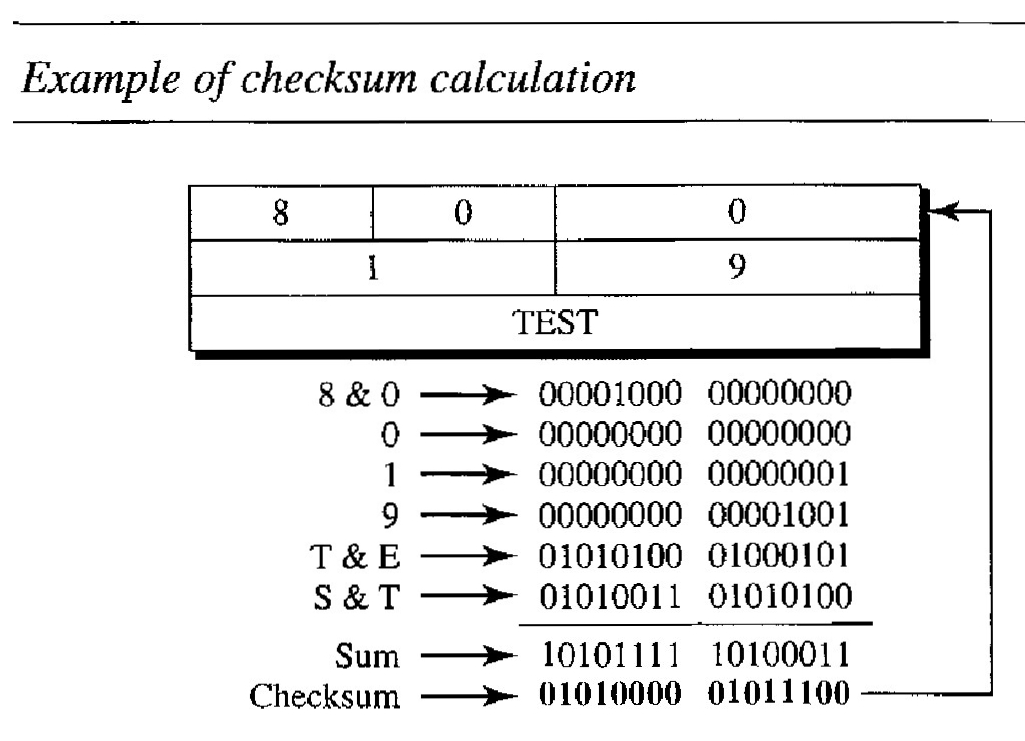
Ping - to find if a host is alive and responding
The source host sends ICMP echo-request messages (type: 8, code: 0); the destina- tion, if alive, responds with ICMP echo-reply messages.
The ping program sets the identifier field in the echo-request and echo-reply message and starts the sequence number from 0; this number is incremented by 1 each time a new message is sent.
Note that ping can calculate the round-trip time. It inserts the sending time in the data section of the message. When the packet arrives, it subtracts the arrival time from the departure time to get the round-trip time (RTT).
Traceroute - can be used to trace the route of a packet from the source to the destination.
We have seen an application of the traceroute program to simulate the loose source route and strict source route options of an IP datagram
The program elegantly uses two ICMP messages, time exceeded and destination unreachable, to find the route of a packet.